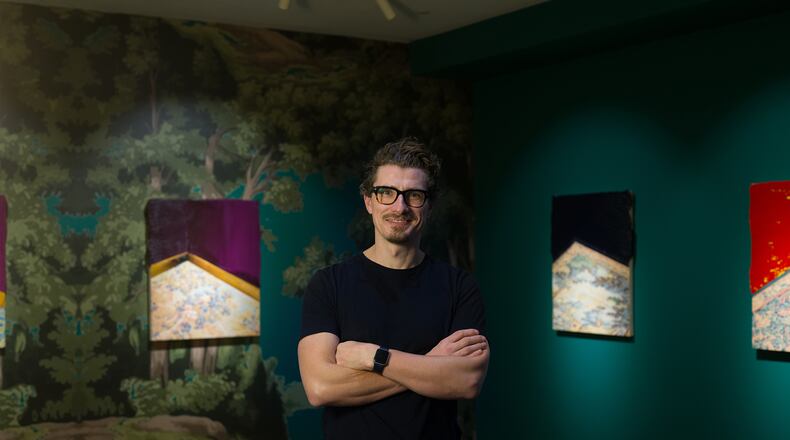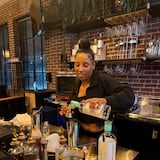Artist Stephen Thorpe, 42, has been in Atlanta for two years, teaching at SCAD after relocating from Hong Kong with his wife Allison. The London-educated artist has been enjoying the accessible Atlanta art community, the ease of getting around, the prevalence of affordable studio space and, of course, “the weather’s bloody good,” he says.
But it’s hard for him to break away from the studio where he tries to keep up with the relentless demand for his paintings. In 2022, Thorpe had solo shows at galleries in Hong Kong and New York, participated in four art fairs and produced 42 paintings.
“Everything sold so I just had to make more work,” Thorpe says.
The paint barely has time to dry on his large-scale paintings — striking juxtapositions of past and present that fuse contemporary painterly techniques with ornate 15th and 16th century Flemish traditions and feature real and mythological animals — before he ships them to his galleries where they sell for $12,000-$45,000.
“I’ve never fallen so madly in love with an artist’s work,” says Wolfgang Gallery owner Benjamin Deaton following a studio visit.
And yet, Thorpe has never sold a piece of art in Atlanta. He’s never had an exhibition here. You won’t find his works hanging at the High Museum of Art.
Welcome to Atlanta’s underground art economy where highly accomplished painters fly under the radar but thrive in the national and international contemporary art market.
Credit: Handout
Credit: Handout
Monica Kim Garza, 35, who lives near Buford Highway’s iconic Plaza Fiesta, has been in Atlanta for six years. Garza’s gorgeous, idiosyncratic nude female figures rooted in her own identity have garnered the artist shows at galleries in Copenhagen; Paris; Cologne, Germany; and New York City — everywhere but Atlanta.
Reynoldstown-based painter Carter Flachbarth, 27, grew up in Atlanta and received a BFA from SCAD. He was named a “noteworthy newcomer” by the online art site Artsy.
Like Thorpe, he is painting as fast as he can, making an average of 25 paintings a year. In 2022 he was featured in the solo exhibition “Picture Show” at Richard Heller Gallery in Los Angeles and in 2023 at the Marfa Invitational art fair. Now he is preparing work for shows at galleries in Seoul and Portugal.
“I’ve been very fortunate that all my presentations have sold out,” he says.
Flachbarth has also never shown his work here.
Credit: Handout
Credit: Handout
His kinetic, contorted, figure-based works draw from the German Expressionist films of the 1920s and currently fetch from $12,000-$20,000. He has collectors around the world but only one in Atlanta who discovered his work at a gallery in Milan.
Flachbarth describes his efforts to show in Atlanta as “missed connections.” When Atlanta galleries finally got around to taking interest in his work, he was already dealing with demand outside the city and obligations to galleries in L.A. and Portugal.
“I love Atlanta. I love living here. Atlanta’s not short on talent or ambition. There’s just this missing chemical X that’s needed to bring it all together,” he says.
These artists are thriving and their work is selling like proverbial hotcakes for five figures. And yet they can’t seem to drum up interest from local galleries.
“Really good contemporary art is based on a premise that hasn’t been done before,” says Deaton. “So introducing that in a commercial setting where your objective is to sell the work — unless you have a lot of very open-minded clients, it can be hard.”
Flachbarth thinks part of the issue may be the influence of Atlanta’s design community, which tends to look for work that is less conceptually challenging.
Painter Patrick Eugene, 38, who lives in Vinings with his chef wife Harryele Eugene and three children, has been in Atlanta for five years after decades living in Brooklyn. Though most of his exhibitions are in places like Ghana, Paris and Chicago, showing in Atlanta would be nice, he says.
“I love the High Museum so I would love to do something with them,” he says. He’d like to have a gallery exhibition in Atlanta so his wife’s family, who live in Georgia, could see his work.
“I think I know and hang out with two ‘art people,’” he says, making light of how little he interacts with the local art community. “For sure, I’m flying under the radar.”
Nevertheless, Atlanta has had a big influence on his work, allowing him to explore figurative work after primarily working in abstraction.
“It wasn’t until I got to Atlanta (that) I allowed myself to slow down and really dive into studying Black artists in particular,” Eugene says. That was “something I was not really doing in New York. There is just so much that inspires me as a Black man in Atlanta.”
Deaton says the reason these artists are doing so well nationally and internationally is twofold. On the one hand, the Internet and social media — especially Instagram — give artists “a way to amplify their voices.” Sites like Platform and Artsy also allow collectors to purchase work by artists outside art world capitals like New York, London and Los Angeles.
Credit: Handout
Credit: Handout
It’s also due to the explosion in the contemporary art market, he says. “We’ve never had so many contemporary artists practicing as a career in human history than we do right now. And that’s because there’s just a broader appreciation of art.”
But the problem with the Atlanta art market for artists like these creating high concept, large scale contemporary work, as Deaton sees it, is the lack of local institutional and collector support. As a result, 80% of Wolfgang Gallery’s buyers are outside Atlanta, he says.
Despite his lack of presence in the local art market, Thorpe extols the reasons he loves the city.
“I think it’s a great place to make work, especially for young artists,” he says. “I wouldn’t be in a rush to go anywhere as a young artist. I’d just be in a rush to make work in an environment I could afford.”
Flachbarth agrees. “If it’s a little quieter of a town, you get to focus on your work more and yourself and your friends and family.”
Perhaps one day the city will return the sentiment.
These are “absolutely phenomenal artists,” says Deaton. “I can say with all of my being, they are some of the best, truly exceptional artists that I’ve ever met.”
But for now, they remain practically unknown in Atlanta.
About the Author







